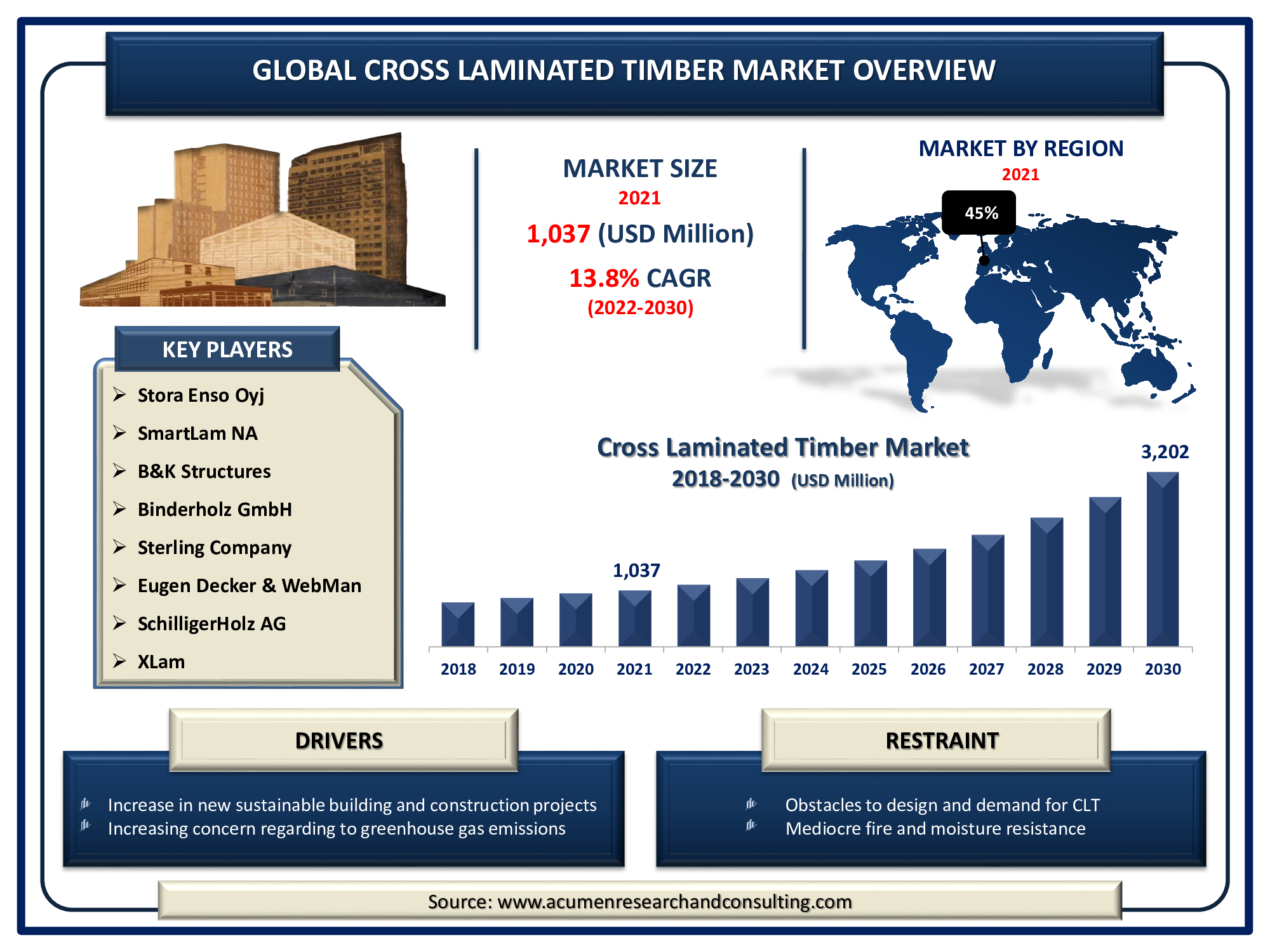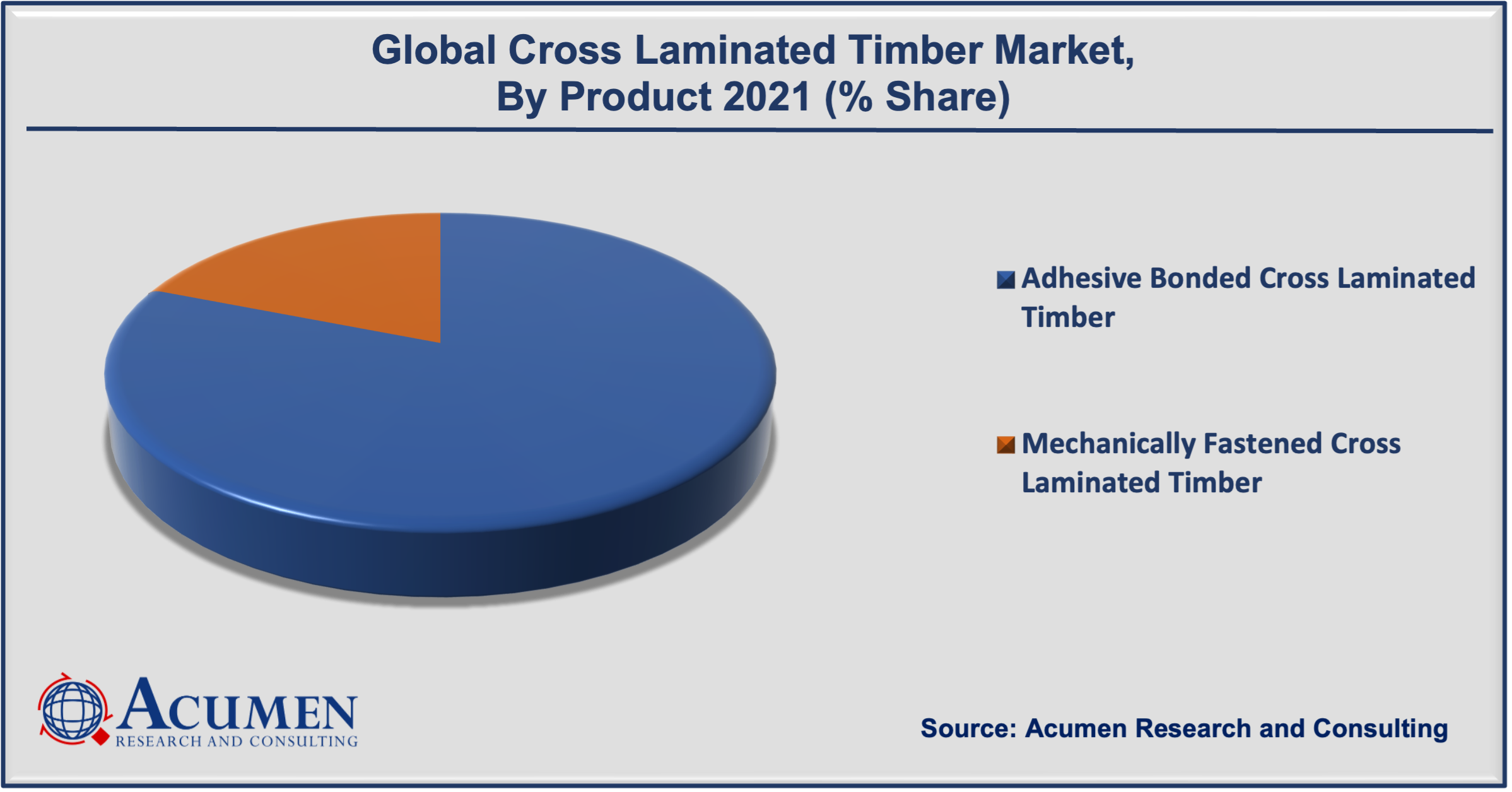September 2021
Cross Laminated Timber Market Size accounted for USD 1,037 Million in 2021 and is expected to reach USD 3,202 Million by 2030 with a considerable CAGR of 13.8%
The Global Cross Laminated Timber Market Size accounted for USD 1,037 Million in 2021 and is expected to reach USD 3,202 Million by 2030 with a considerable CAGR of 13.8% during the forecast timeframe from 2022 to 2030.

Cross-laminated timber market growth is predicted to be driven by consumer demand for luxurious and modern residences, as well as increased use of CLT in residential applications such as floors, ceilings, and walls. Furthermore, as wood evolves as a low-cost and environmentally friendly alternative to concrete and steel, demand for the cross-laminated timber market is expected to rise in the coming years.
Cross-laminated timber (CLT), like plywood, is a lightweight but exceptionally robust building material reinforced with many layers of solid lumber. To adhere the surfaces together, adhesives are employed, typically in an unequal number of layers and sometimes in an even number. CLT planks are kiln-dried as well as stacked in sequential directions, improving their ability to endure weight load and equalization on all sides. CLT is also a long-lasting material that may be used for a range of purposes, including flooring, walls, and roofing. It can also be used in conjunction with other construction materials such as metals and concrete to offer additional support. However, owing to its timber frame construction, it also looks stunning and exposed in interior environments. It's also durable enough to be employed in a wide range of projects, from homes to multi-family and industrial buildings.
Cross Laminated Timber Market Drivers
Cross Laminated Timber Market Restraints
Cross Laminated Timber Market Opportunity
Report Coverage
| Market | Cross Laminated Timber Market |
| Market Size 2021 | USD 1,037 Million |
| Market Forecast 2030 | USD 3,202 Million |
| CAGR During 2022 - 2030 | 13.8% |
| Analysis Period | 2018 - 2030 |
| Base Year | 2021 |
| Forecast Data | 2022 - 2030 |
| Segments Covered | By Product, By Application, And By Geography |
| Regional Scope | North America, Europe, Asia Pacific, Latin America, and Middle East & Africa |
| Key Companies Profiled | Stora Enso Oyj, SmartLam NA, Mayr-MelnhofHolz Holding AG, B&K Structures, Binderholz GmbH, Sterling Company, Eugen Decker & WebMan, SchilligerHolz AG, Structurlam Mass Timber Corporation, KLH Massivholz GmbH, XLam, and MEIKEN LAMWOOD Corp. |
| Report Coverage |
Market Trends, Drivers, Restraints, Competitive Analysis, Player Profiling, Regulation Analysis |
| Customization Scope |
10 hrs of free customization and expert consultation |
Cross Laminated Timber Market Dynamics
The growing demand for wooden residential buildings with more design freedom and aesthetic appeals, such as multifamily flats and single-family homes, is accelerating the domestic applicability in the cross-laminated timber market at a rapid rate. The increased fire resistance and earthquake resistance are expected to boost the global cross-laminated timber market size over the forecast period. Shifting construction approaches away from cementations materials and toward wood-based architecture for developing product uses, supported by government policies such as stringent CO2 emission criteria and norms, is expected to promote the growth of the cross-laminated timber market value.
According to the cross-laminated timber industry analysis, the demand and supply of cross-laminated timber are expected to expand due to benefits such as environmental friendliness, cost-efficiency, waste reduction, and enhanced quality. The reduced project duration and increasing diversity of products and services are projected to promote revenue sales in the cross-laminated wood market. In addition, the fall of the cross-laminated timber business is attributed to poor acoustic properties and increased use of dangerous adhesives or solvents.
Cross Laminated Timber Market Segmentation
The global cross laminated timber market segmentation based on the product, application and geographical region.
Cross Laminated Timber Market By Product

In terms of product, the adhesive-bonded segment will dominate the industry in 2021. The use of such high-strength adhesives for plank bonding is predicted to boost demand in a variety of application areas, including institutional, commercial, and residential. The cost of manufacturing adhesive-bonded cross-laminated timber is cheaper than that of mechanically fastened CLT since less machinery is utilized. Additionally, at the end of their life cycle, the adhesive-bonded cross-laminated timber boards can be turned into bioenergy granules. Based on the construction needs, these panels are custom constructed to their present proportions, resulting from reduced wood waste.
According to the cross-laminated timber market forecast, the mechanically fastened segment is predicted to grow at a rapid pace in the industry. Due to environmental concerns regarding the use of petrochemical-based adhesives and other hazardous materials, the market share for mechanically fastened CLT is likely to expand. Furthermore, mechanically fastened lumber is easy to replace, which opens up new cross laminated timber market trend.
Cross Laminated Timber Market By Application
Based on the application, the residential segment is predicted to develop at the fastest rate in the market over the next several years. Cross-laminated timber (CLT) is a constructed wooden panel made by bonding layers of solid-sawn hardwood that are generally perpendicular to subsequent layers in symmetrical patterns and used as load-bearing portions for construction frameworks such as partitions, flooring, ceilings, and walls. Cross-laminated wood is also used for external and interior cladding. Furthermore, the growing use of eco-friendly construction components and seismic carrying capacity is expected to result in higher demand in earthquake-prone areas such as emerging market economies during the forecast period. Furthermore, the better structural durability and recyclability of cross-laminated timber are expected to drive market expansion in the residential sector.
Cross Laminated Timber Market Regional Outlook
North America
Europe
Latin America
Asia-Pacific
The Middle East & Africa (MEA)
Europe is expected to lead the global market throughout the projected year. Due to the booming building and construction industries in countries such as Germany, the United Kingdom, Italy, and France, the usage of cross-laminated timber is increasing in the region. In Europe, the primary market for CLT has been family housing development, as well as commercial and industrial development. The need for more multi-family housing is shifting as building codes and technologies improve. Consumer demand for higher-end homes is expected to grow, driving the overall market growth. The availability of appropriate supply from timber woodlands, as well as continual innovations in timber processing methods, are expected to drive the expansion of the European cross-laminated timber industry.
Cross Laminated Timber Market Players
Some of the prominent global cross laminated timber market companies is Stora Enso Oyj, SmartLam NA, Mayr-MelnhofHolz Holding AG, B&K Structures, Binderholz GmbH, Sterling Company, Eugen Decker & WebMan, SchilligerHolz AG, Structurlam Mass Timber Corporation, KLH Massivholz GmbH, XLam, and MEIKEN LAMWOOD Corp.
Looking for discounts, bulk pricing, or custom solutions? Contact us today at sales@acumenresearchandconsulting.com
September 2021
June 2024
January 2025
March 2025